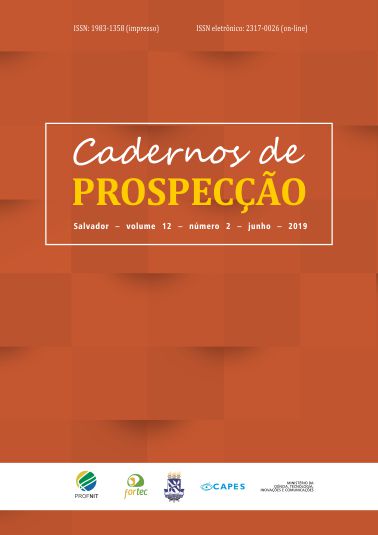Soil Method Contaminated Soil Phytremediation
DOI:
https://doi.org/10.9771/cp.v12i2.27308Keywords:
Technological prospecting, Bioremediation, Phytoextraction, Mining.Abstract
Phytoremediation is a technique that uses plants to remedy areas contaminated with heavy metals. This technique has great advantage due to the high diversity of vegetables that can be found in nature. This work aimed to make a technological survey of the phytoremediation methods used in the recovery of environments impacted by heavy metals. The research was carried out in the patent databases of the European Patent Office (Espacenet®) and the National Institute of Industrial Property (INPI), using the keywords: remediation, plant, soil, heavy metal, recovery and phytoremediation, and codes the B09C1/00 and A01H5/00 of the International Patent Classification. China was the highlight in this research, presenting the main inventors and universities holding patents, having the peak of deposit in the year 2009. The phytoremediation technique that is being more used is phytoextraction. Phytoremediative technologies are proving to be very promising for a market that is increasingly demanding and concerned about environmental impacts.
Downloads
References
BENTES, M. China anuncia que enorme área de seu território está com solo contaminado. 2014. Disponível em: <http://jornalggn.com.br/noticia/china-anuncia-que-enorme-area-de-seu-territorio-esta-com-solo-contaminado>. Acesso em: 18 set. 2017.
EUROPEAN PATENT OFFICE (Espacenet). Portal virtual. 2017. Disponível em: <https://worldwide.espacenet.com>. Acesso em: 1º ago. 2017.
INSTITUTO NACIONAL DE PROPRIEDADE INDUSTRIAL (INPI). Portal virtual. 2017. Disponível em: <http://www.inpi.gov.br/>. Acesso em: 1º ago. 2017.
MAYERHOFF et al. Instituto Nacional de Propriedade Industrial (INPI). Grupo de Trabalho Especial em Biotecnologia. Estudo comparativo dos critérios de patenteabilidade para invenções biotecnológicas em diferentes países. 2007. Disponível em: <http://www.inpi.gov.br/menu-servicos/informacao/arquivos/estudo_comparativo_dos_critriosde_petenteabilidadepara_invenes_biotecnolgicas_em_diferentes_pases1.pdf>. Acesso em: 17 set. 2017.
NASCIMENTO, C.W. A.; XING, B. Phytoextraction: a review on enhanced metal availability and plant accumulation. Scientia Agricola, São Paulo, v. 63, p. 299–311, 2006.
RASKIN, I.; ENSLEY, B. Phytoremediation of toxic metals – using plants to clean up the environment. Plant Science, [S.l.], v. 160, p. 1073–1075, 2000.
RIBEIRO, M. A. C. Contaminação do solo por metais pesados. 2013. Disponível em: <http://recil.grupolusofona.pt/bitstream/handle/10437/4770/TeseFinalMarcosRibeiro27-01-14.pdf?sequence=1>. Acesso em: 1º set. 2017.
SILVA, J. F. Prospecção de plantas fitorremediadoras em solos contaminados por metais pesados. 2012. 91 f. Tese (Doutorado em Biotecnologia) – Programa Multi-Institucional de Pós-Graduação em Biotecnologia. Universidade Federal do Amazonas, Manaus, 2012.
SOBRINHO, Amaral et al. Química dos metais pesados no solo. In: MELO, V. F.; ALLEONI, L. R. F. (Ed.). Química e mineralogia do solo: aplicações. Viçosa, MG: SBCS, 2009.
ZUCOLOTO, F. G. Propriedade intelectual e aspectos regulatórios em biotecnologia. Rio de Janeiro: Ipea, 2013. Cap. 5. Disponível em: <http://protec.org.br/uploads/paginas/file/Propriedade%20Intelectual%20e%20aspectos%20regulat%C3%B3rios%20em%20biotecnologia.pdf>. Acesso em: 17 set. 2017.
Downloads
Published
How to Cite
Issue
Section
License
Copyright (c) 2019 Cadernos de Prospecção

This work is licensed under a Creative Commons Attribution-NonCommercial 4.0 International License.
O autor declara que: - Todos os autores foram nomeados. - Está submetendo o manuscrito com o consentimento dos outros autores. - Caso o trabalho submetido tiver sido contratado por algum empregador, tem o consentimento do referido empregador. - Os autores estão cientes de que é condição de publicação que os manuscritos submetidos a esta revista não tenham sido publicados anteriormente e não sejam submetidos ou publicados simultaneamente em outro periódico sem prévia autorização do Conselho Editorial. - Os autores concordam que o seu artigo ou parte dele possa ser distribuído e/ou reproduzido por qualquer forma, incluindo traduções, desde que sejam citados de modo completo esta revista e os autores do manuscrito. - Revista Cadernos de Prospecção está licenciado com uma Licença Creative Commons Attribution 4.0. Esta licença permite que outros remixem, adaptem e criem a partir do seu trabalho para fins não comerciais, e embora os novos trabalhos tenham de lhe atribuir o devido crédito e não possam ser usados para fins comerciais, os usuários não têm de licenciar esses trabalhos derivados sob os mesmos termos.
Este obra está licenciado com uma Licença Creative Commons Atribuição 4.0 Internacional.





